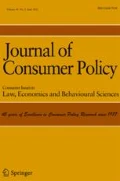Abstract
The paper analyses the “advertising as power” vs. “advertising as information” controversy as well as its recent empirical testing. It is stressed that this distinction focuses too much on the interaction between consumer and manufacturer while ignoring the retailer as an important stake-holder. To compensate for this lack, a complex marketing system perspective is introduced in which consumer, retailer, and manufacturer interact. However, these complex marketing systems might drift towards market equilibria which are against the consumer interests: that is, firmsmight lock out brands from the market by means of trade and sales promotions and then use advertising to protect their position. Consequently brands of better quality and/or innovative brands are barred from trade shelves.
Zusammenfassung
Der Beitrag behandelt die kontroverse Gegenüberstellung von Werbung als Marktmacht und Werbung als Information, sowie einen neueren Versuch, diese Kontroverse empirisch zu entscheiden. Der Autor betont, da\ sich die Kontroverse zu stark auf die Interaktion zwischen Konsument und Hersteller konzentriert, wÄhrend der Handel als eigenstÄndig beteiligte Instanz übersehen wird. Um diesen Mangel zu beheben, führt er eine komplexere Perspektive des Marketingsystems ein, in welcher alle drei Instanzen interagieren. Die Analyse ergibt jedoch, da\ sich solche komplexe Marketingsysteme auf Gleichgewichte zubewegenkönnen, die gegen das Konsumenteninteresse gerichtet sind. Unternehmen können Konkurrenten mit handelspolitischen Ma\nahmen vom Markt fernhalten und dann ihre eigene Position mit Mitteln der Werbung schützen. Folgich können Marken besserer QualitÄt oder innovative Produktenwicklungen vom Markt ferngehalten werden.
Similar content being viewed by others
References
Akerlof, G. (1970). The market for “lemons”: Quality uncertainty and the market mechanism.Quarterly Journal of Economics, 89, 488–500.
Albion, M. (1983).Advertising's hidden effects. Boston: Auburn House.
Allaian, B. (1990). Science 1, advertisers 0.US News and World Report, May, p. 61.
Arthur, B. (1988). Self-reinforcing mechanisms in economics. In: P. Anderson, K. Arrow, & D. Pines (Eds.),The economics as an evolving complex system, pp. 9–31. New York: Addison Wesley.
Arthur, B. (1990). Positive feedbacks in the economy.Scientific American, No. 263, pp. 92–99.
Carman, J. (1970). Correlates of brand loyalty: Some positive results.Journal of Marketing Research, 7, 67–76.
Comanor, W., & Wilson, T. (1974).Advertising and market power. Cambridge, MA: Harvard University Press.
de Soet, J. (1989) Betere waar en 15% korting (Better goods and 15% reduction).Nieuwstribune, November 30, pp. 6–7.
Dickson, P., & Sawyer, A. (1990). The price knowledge and search of supermarket shoppers.Journal of Marketing, 64(3), 42–53.
Farris, P., Olver, J., & deKluyver, C. (1989). The relationship between distribution and market share.Management Science, 8, 131–148.
Farris, P., & Quelch, J. (1987).Advertising and promotion management. Malabar: R. E. Krieger.
Farris, P., & Reibstein, D. (1984). Over control in advertising experiments.Journal of Advertising, 24(3), 37–44.
Gupta, P. (1988). Marketing wars — Strategy in action. In:De Praktijk van Denken en Doen, pp. 65–66. Amsterdam: NIMA Congres Jaarboek.
Heeler, R., Kearney, M., & Mehaffey, B. (1973). Modelling supermarket product selection.Journal of Marketing Research, 10, 34–37.
Hirschman, A. (1970).Exit, voice, and loyalty. Cambridge, MA: Harvard University Press.
Kuehn, A. (1961). A model for budgeting advertising. In: F. Bass et al. (Eds.),Mathematical models and methods in marketing, pp. 315–348. Homewood, IL: Irwin.
Morris, R. (1971). Major firms comparatively evaluated.Journal of Consumer Affairs, 5, 119–139.
Morris, R., & Bronson, C. (1969). The chaos of competition indicated by Consumer Reports.Journal of Marketing, 33, 26–34.
Nelson, P. (1970). Information and consumer behaviour.Journal of Political Economy, 78, 311–329.
Nelson, P. (1974). Advertising as information.Journal of Political Economy, 81, 729–754.
Nicolis, G., & Prigogine, I. (1989).Exploring complexity. New York: W. H. Freeman.
Quelch, J. (1989).How to market to consumers. New York: Wiley.
Rothenberg, R. (1989). Shifts in marketing strategy jolting advertising industry.New York Times, October 3, pp. a1/d22/d23.
Savitt, R. (1987). Entrepreneurial behaviour and marketing strategy. In: A. Firat, N. Dholakia, & R. Bagozzi (Eds.),Philosophical and radical thought in marketing, pp. 307–322. Cambridge, MA: Lexington Books.
Smolensky, P. (1989). Connectionistic modeling: Neural computation/mental connections. In: L. Nadel, L. Cooper, P. Culicover, & R. Harnish (Eds.),Neural connections, mental computation, pp. 49–67. Cambridge, MA: MIT Press.
Steiner, R. (1978). A dual stage approach to the effect of brand advertising on competition and price. In: J. Cady (Ed.),Marketing and the public interest, pp. 127–150. Cambridge, MA: Marketing Science Institute.
Tellis, G. (1988). Advertising exposure, loyalty, and brand purchase: A two-stage model of choice.Journal of Marketing Research, 25, 134–144.
Tellis, G., & Fornell, C. (1988). The relationship between advertising and quality over the product life cycle: A contingency theory.Journal of Marketing Research, 25, 64–71.
Wind, Y. (1982).Product policy: Concepts, methods, and strategy. Reading: Addison-Wesley.
Author information
Authors and Affiliations
Rights and permissions
About this article
Cite this article
Verbeke, W. Advertising, product quality, and complex evolving marketing systems. J Consum Policy 15, 143–158 (1992). https://doi.org/10.1007/BF01352133
Issue Date:
DOI: https://doi.org/10.1007/BF01352133




